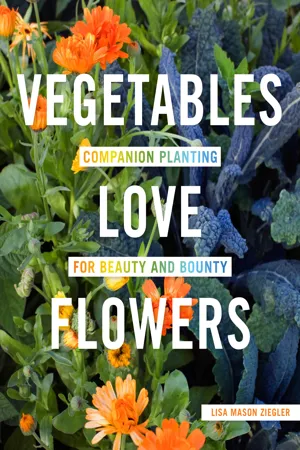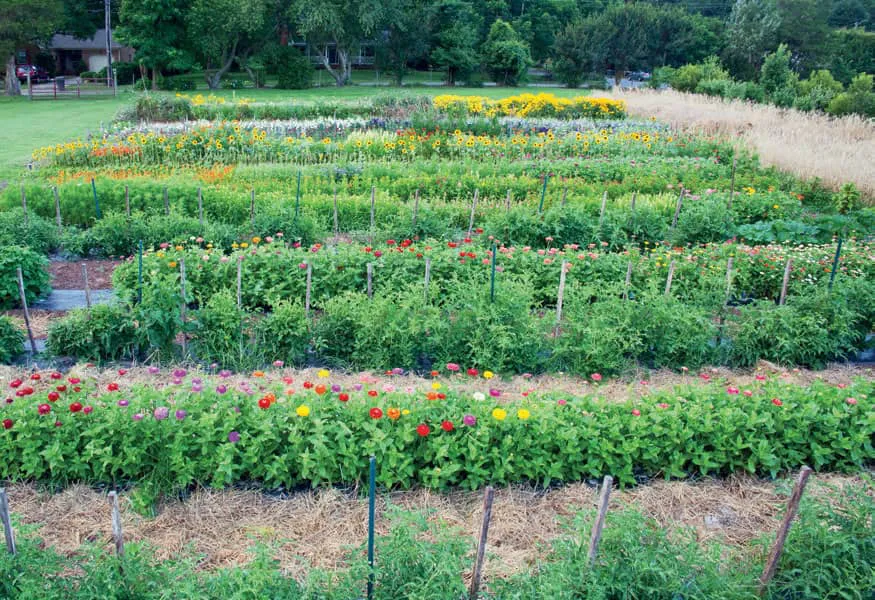SECTION 1
Flowers In The Vegetable Garden
When you bring flowers into your vegetable patch, be prepared for good things to happen. With a small cutting garden tucked in with the vegetables, it is easy to keep flowers blooming for the beneficial insects, pollinators, and other good things. The fresh bouquets are a bonus for you! Harvesting the flowers regularly just as you do vegetables keeps the plants producing blooms throughout the growing season. A little-known fact about cutting gardens is that they don’t need much space because the continuous harvesting stimulates so many fresh blossoms. It still surprises me how many flowers a small area can produce.
As you become familiar with all the benefits flowers have to offer, you will be eager to get them started in your patch. My suggested garden plans in the appendix are a jumping-off point to tweak to your needs. The plans demonstrate how to succession plant through the four seasons and to never leave the soil bare and exposed. The silver lining of this first section of the book is taking to heart how to treat a cutting garden. No matter where you garden, one truth holds true: the flowers in a cutting garden must be harvested on a regular basis to survive and thrive. The more you cut, the more they come, I promise!
Squash, cucumbers, and tomatoes growing in harmony with flowers. Not only do the flowers attract bees and beneficial insects, they make the garden beautiful.
CHAPTER 1
Why Do Vegetables Love Flowers?
I have been in a unique position the past 19 years as an urban cut-flower farmer. I spend 6 months of the year standing out in my garden for countless hours each week harvesting flowers and watching the day go by. I have witnessed things I would never have guessed were possible, much less happening in my own garden. As a farmer, gardener, birdwatcher, and general wildlife lover, I am surprised by what I see. And to think it all happens in the middle of a city of 200,000 residents.
All this action in my garden wasn’t always the case. It came as I moved my focus away from “just” growing plants to focusing on beefing up the ecosystem so it could grow healthy, robust plants naturally. That’s when the garden came alive. What does that mean? You could say that organic gardening is rooted in preventive medicine. I began to garden in advance of possible problems. I learned to do the chores that prevented issues instead of running after the problems, picking up the pieces and trying to fix them. It turns out to be an easier, less stressful, and more cost-effective way to garden. The truth is, I can’t imagine having farmed all these years without following nature’s lead.
Beneficial insects are attracted to the garden by the flowers. With flowers grown alongside the vegetables, they don’t have far to go to find pests.
I see and hear so much during all the hours I spend harvesting flowers on the farm—it hardly seems like work at times.
While you’re in my garden you would never guess that just outside my property line is a bustling neighborhood located in the midst of a city.
My gardening experiences have unfolded in the middle of a neighborhood with school buses rattling by, neighbors’ blowers going, and even the occasional city mosquito truck spraying its mist over the area. Nature can overcome much because it never stops trying. Pest insects seem to come so quickly when you plant their delight (like squash bugs to squash), but it is just as true for the good things of the garden—plant their delights and they too will come.
Without flowers, there is no reason for any of these good things to come, much less stay and call the garden home. The experiences I share are not exceptions or even every-now-and-then happenings; this kind of stuff is happening day in and day out right here in my city garden. In fact, I get so caught up in watching it unfold that at times my farm coworkers inquire whether we are working or watching nature today.
COMPANY’S COMING
Because of the ladybug, gardeners everywhere have gained an understanding of how powerful beneficial insects can be and the impact they have in a garden.
Adding flowers will likely bring you face to face with one of the most well-known beneficial insects, the ladybug. Show a photo to even nongardeners, and they are almost sure to recognize its cute little red body with polka dots. It is said that the ladybug came to fame because farmers believed it was sent to deliver them from the ravages of pest attacks back in the day. Regardless of how it came to be famous, the fact remains that the ladybug is a fantastic example of nature helping us solve a problem—one little ladybug can eat thousands of aphids and other garden pests in its lifetime. How’s that for pest control?
The great news is that there’s an army of other insects just like ladybugs that patrol the garden and solve problems. Some prey on pests and eat them, while others will parasitize the pest, eventually killing it. There are minute pirate bugs that, in spite of their tiny 1/16-inch size, will consume thrips and mites. There are damsel bugs that will gobble up soft-bodied pests. The garden becomes home to a diverse mix of problem-solving beneficial insects that come for the flowers and stay for the pests. Without flowers, pests can run rampant and create a host of problems that lead our gardens astray.
Because I hang out in the garden so much, I can’t help but notice the little dramas playing out on my plants and in my soil. Did you know that some wasps are meat eaters? They patrol the garden looking for caterpillars and other insects to sting and carry back to their nest for food. Those large black beetles that are crawling around the garden? They capture and eat soil-dwelling insects such as slugs, maggots, and wireworms. I hope it is becoming clear just how the garden can take care of its own business when given a chance.
If the promise of good bugs eating bad bugs isn’t enough reason to give flowers some room in the vegetable patch, I have more. There’s a community of ready and able pollinators that most folks hardly know exist. Native bees, just like their honeybee relatives, are suffering at the hand of habitat loss and pesticide exposure. There are thous...





